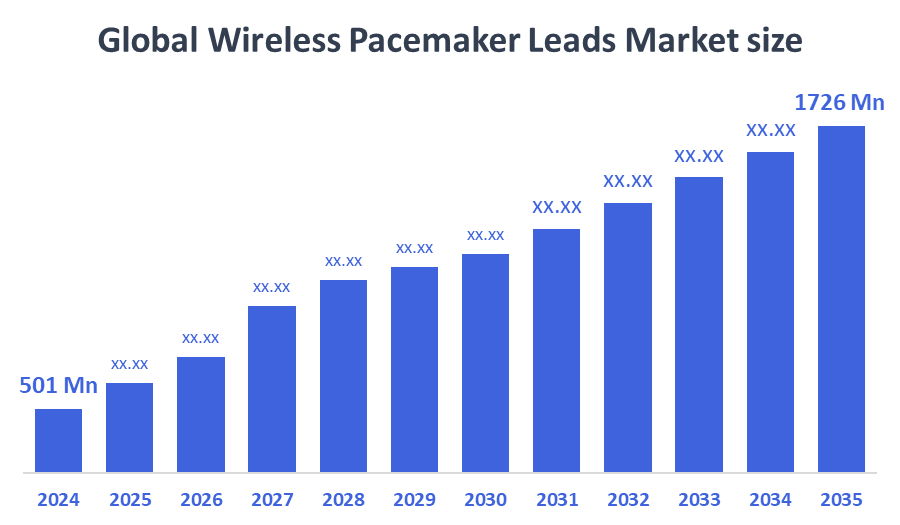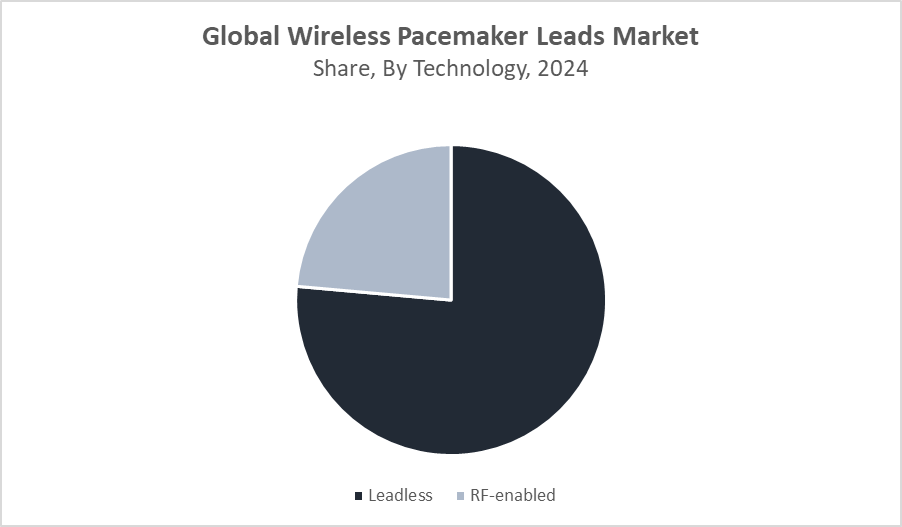Global Wireless Pacemaker Leads Market
Global Wireless Pacemaker Leads Market Size, Share, and COVID-19 Impact Analysis, Impact of Tariff and Trade War Analysis, By Technology (Leadless and RF-enabled), By Application (Bradycardia, Tachycardia, and Atrial Fibrillation), and By Region (North America, Europe, Asia-Pacific, Latin America, Middle East, and Africa), Analysis and Forecast 2025 - 2035
Report Overview
Table of Contents
Wireless Pacemaker Leads Market Summary, Size & Emerging Trends
According to Decision Advisors, The Global Wireless Pacemaker Leads Market Size is Expected to Grow from USD 501 Million in 2024 to USD 1726 Million by 2035, at a CAGR of 11.9% during the forecast period 2025-2035. The increasing prevalence of cardiovascular diseases, growing adoption of minimally invasive cardiac devices, and technological innovations in wireless pacemaker leads are the key growth drivers. Additionally, patient preference for leadless systems to reduce complications and advancements in remote monitoring contribute significantly to market expansion.

Key Market Insights
- Leadless pacemaker leads are expected to dominate the market due to their minimally invasive nature and reduced risk of lead-related complications.
- Bradycardia application holds the largest share as it is the most common cardiac condition treated using pacemakers.
- North America leads the market with the highest share driven by technological advancements and healthcare expenditure, while Asia Pacific is the fastest-growing region.
Global Market Forecast and Revenue Outlook
- 2024 Market Size: USD 501 Million
- 2035 Projected Market Size: USD 1726 Million
- CAGR (2025-2035): 11.9%
- North America: Largest market in 2024
- Asia Pacific: Fastest growing market
Wireless Pacemaker Leads Market
Wireless pacemaker leads are essential for connecting pacemaker devices to the heart without using traditional wires. By eliminating physical leads, they reduce complications such as infections, lead displacements, and fractures, improving patient safety and comfort. The rising prevalence of cardiac arrhythmias and the growing elderly population, who often need pacemaker implants, fuel the demand for these advanced devices. Innovations like smaller lead designs and integration with remote monitoring technologies further enhance their effectiveness and convenience. Moreover, supportive regulatory frameworks and favorable reimbursement policies in developed countries encourage adoption and market expansion. Together, these factors contribute to steady growth in the wireless pacemaker leads market, making it a crucial segment within the cardiac medical device industry.
Wireless Pacemaker Leads Market Trends
- Surge in leadless pacemaker systems that eliminate the need for traditional leads, reducing surgical complications.
- Growing integration of wireless telemetry for real-time patient monitoring and data transmission.
- Strategic partnerships between medical device companies and technology firms to innovate advanced leads.
- Increased focus on battery life enhancement to reduce device replacements and improve patient comfort.
Wireless Pacemaker Leads Market Dynamics
Driving Factors: Technological advancements in wireless communication
The wireless pacemaker leads market is driven by the rising prevalence of cardiovascular diseases globally and the growing preference for minimally invasive cardiac treatments. Technological advancements in wireless communication and energy-efficient lead designs boost adoption rates. Additionally, favourable reimbursement policies and increased healthcare spending in developed regions support market expansion. Growing patient awareness about complications linked to traditional leads also fuels demand for wireless options, making these devices a safer and more attractive alternative.
Restrain Factors: Complex regulatory approvals and strict quality standards lengthen development cycles
High costs of wireless pacemaker systems and leads restrict adoption, especially in price-sensitive markets. Complex regulatory approvals and strict quality standards lengthen development cycles. The limited number of trained specialists to implant these advanced systems, combined with concerns about long-term reliability, further hinder market growth and widespread acceptance.
Opportunity: Innovations in lead materials
Emerging regions like Asia Pacific and Latin America offer strong growth potential due to expanding healthcare infrastructure and rising cardiac disease incidence. Innovations in lead materials, wireless power transfer, and remote monitoring can increase product appeal. Partnerships between manufacturers and healthcare providers to promote clinical education and awareness can speed up adoption.
Challenges: Supply chain issues
Supply chain issues, especially shortages of semiconductors and specialized materials, threaten consistent production. Geopolitical tensions disrupting medical device trade may delay market growth. Additionally, competition from alternatives like subcutaneous ICDs and traditional wired leads limits the wireless pacemaker leads market’s share expansion.
Global Wireless Pacemaker Leads Market Ecosystem Analysis
The global wireless pacemaker leads market ecosystem includes key players such as device manufacturers, component suppliers, healthcare providers, and regulatory bodies. Manufacturers focus on innovation in lead design, wireless communication, and energy efficiency. Component suppliers provide specialized materials and semiconductors crucial for production. Healthcare providers drive adoption through implantation and patient care, while regulatory agencies ensure safety and efficacy standards. Collaboration among these stakeholders is essential for advancing technology, improving patient outcomes, and expanding market reach worldwide.
Global Wireless Pacemaker Leads Market, By Technology
Leadless pacemaker leads are expected to dominate the wireless pacemaker leads market, holding approximately 60% market share. These systems eliminate the need for traditional transvenous leads, significantly reducing risks of lead-related complications such as infection, dislodgement, or fracture. Their minimally invasive implantation process makes them highly favorable for elderly and high-risk patients. Leadless systems also improve patient mobility and comfort. As clinical outcomes continue to support their efficacy and safety, their adoption is rapidly increasing in both developed and emerging healthcare settings.

RF-enabled pacemaker leads account for about 40% of the market share, offering advanced wireless communication between pacemakers and external monitoring systems. These leads allow for real-time data transmission, enabling remote diagnostics and continuous patient monitoring. This is particularly beneficial for chronic heart disease management and post-implantation care. While slightly more complex in design than leadless systems, RF-enabled leads are preferred in specific clinical scenarios requiring higher communication functionality, especially in hospital-based settings.
Global Wireless Pacemaker Leads Market, By Application
Bradycardia applications lead the wireless pacemaker leads market with an estimated 50% market share. This dominance stems from bradycardia being the most prevalent condition requiring pacemaker implantation, where the heart beats too slowly to meet the body’s needs. Wireless leads offer a safer, less invasive solution compared to traditional systems, especially beneficial for elderly patients. Their ability to provide consistent pacing without lead-related complications makes them ideal for long-term management of bradycardia, contributing significantly to market growth.
Tachycardia applications account for approximately 30% of the market, driven by increasing cases of abnormal fast heart rhythms requiring advanced pacing therapies. Wireless pacemaker leads are being adopted for complex arrhythmia management where rapid intervention and precise control are essential. Their integration with monitoring systems allows real-time tracking of heart rate fluctuations, improving treatment outcomes. As demand for advanced and personalised arrhythmia care rises, adoption of wireless pacing systems for tachycardia is expected to grow steadily.
North America holds the largest share of around 35% in the global wireless pacemaker leads market.
This dominance is attributed to a well-established healthcare infrastructure, early availability of innovative cardiac technologies, and a high prevalence of cardiovascular diseases, especially in the U.S. The region benefits from the presence of major medical device manufacturers like Medtronic and Abbott, along with strong regulatory frameworks and favourable reimbursement systems. High awareness levels among patients and healthcare professionals further support rapid adoption of wireless pacemaker technologies, positioning North America as a mature and innovation-driven market.
Asia Pacific is the fastest-growing region, projected to expand at a CAGR of approximately 11% over the forecast period.
Factors contributing to this rapid growth include a surge in cardiac disease cases, growing geriatric population, and rising awareness of advanced treatment options. Countries like India, China, and Japan are heavily investing in healthcare modernisation, infrastructure upgrades, and public health programs. Additionally, increased training initiatives and collaborations with global device manufacturers are improving the accessibility and affordability of advanced cardiac solutions, making the region a significant growth hub for wireless pacemaker leads.
WORLDWIDE TOP KEY PLAYERS IN THE WIRELESS PACEMAKER LEADS MARKET INCLUDE
- Medtronic
- Abbott Laboratories
- Boston Scientific
- BIOTRONIK
- MicroPort Scientific Corporation
- LivaNova
- Lepu Medical Technology
- Nuvectra Corporation
- EBR Systems
- Oscor Inc.
- Others
Market Segment
This study forecasts revenue at global, regional, and country levels from 2020 to 2035. Spherical Insights has segmented the wireless pacemaker leads market based on the below-mentioned segments:
Global Wireless Pacemaker Leads Market, By Technology
- Leadless Leads
- RF-Enabled Leads
Global Wireless Pacemaker Leads Market, By Application
- Bradycardia
- Tachycardia
- Atrial Fibrillation
Global Wireless Pacemaker Leads Market, By Regional Analysis
- North America
- US
- Canada
- Mexico
- Europe
- Germany
- UK
- France
- Italy
- Spain
- Russia
- Rest of Europe
- Asia Pacific
- China
- Japan
- India
- South Korea
- Australia
- Rest of Asia Pacific
- South America
- Brazil
- Argentina
- Rest of South America
- Middle East & Africa
- UAE
- Saudi Arabia
- Qatar
- South Africa
- Rest of the Middle East & Africa
FAQs
Q. What is the projected growth rate of the Global Wireless Pacemaker Leads Market from 2025 to 2035?
The market is expected to grow at a CAGR of 11.9% during the forecast period 2025 to 2035.
Q. What was the market size of wireless pacemaker leads in 2024, and what is it expected to be in 2035?
The market size was approximately USD 501 million in 2024 and is projected to reach USD 1,726 million by 2035.
Q. Which region holds the largest market share in 2024?
North America holds the largest market share, accounting for about 35% of the global wireless pacemaker leads market.
Q. Which region is the fastest-growing for wireless pacemaker leads?
The Asia Pacific region is the fastest-growing market, with a projected CAGR of approximately 11% due to increasing healthcare investments and a rising elderly population.
Q. What are wireless pacemaker leads and why are they important?
Wireless pacemaker leads connect pacemaker devices to the heart without using traditional wires, reducing complications like infections and lead displacements, improving patient safety and comfort.
Q. What are the main types of wireless pacemaker leads available in the market?
The two main types are Leadless Leads (about 60% market share) and RF-enabled Leads (about 40% market share).
Q. What cardiac condition holds the largest application share for wireless pacemaker leads?
Bradycardia holds the largest share, accounting for approximately 50% of the market due to its high prevalence and the suitability of wireless leads for treatment.
Q. What are the key factors driving the growth of the wireless pacemaker leads market?
Key drivers include the increasing prevalence of cardiovascular diseases, technological advancements, patient preference for minimally invasive procedures, and favourable reimbursement policies.
Q. What are the primary challenges facing the wireless pacemaker leads market?
Challenges include complex regulatory approvals, high costs of devices, supply chain disruptions, and a limited number of trained specialists for device implantation.
Q. Who are some of the leading players in the wireless pacemaker leads market?
Major companies include Medtronic, Abbott Laboratories, Boston Scientific, BIOTRONIK, MicroPort Scientific Corporation, LivaNova, and others who are driving innovation and market expansion.
Check Licence
Choose the plan that fits you best: Single User, Multi-User, or Enterprise solutions tailored for your needs.
We Have You Covered
- 24/7 Analyst Support
- Clients Across the Globe
- Tailored Insights
- Technology Tracking
- Competitive Intelligence
- Custom Research
- Syndicated Market Studies
- Market Overview
- Market Segmentation
- Growth Drivers
- Market Opportunities
- Regulatory Insights
- Innovation & Sustainability
Report Details
| Pages | 152 |
| Delivery | PDF & Excel via Email |
| Language | English |
| Release | Sep 2025 |
| Access | Download from this page |
